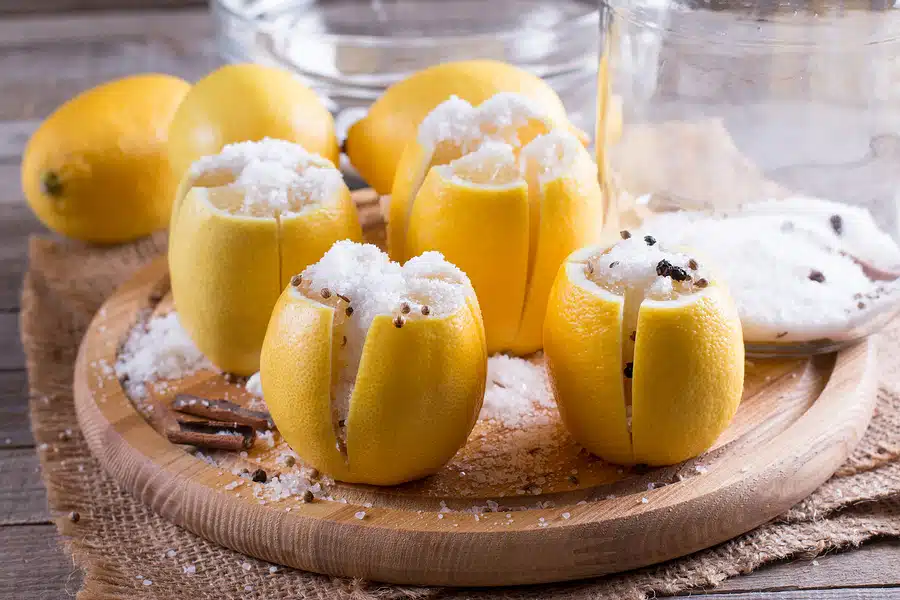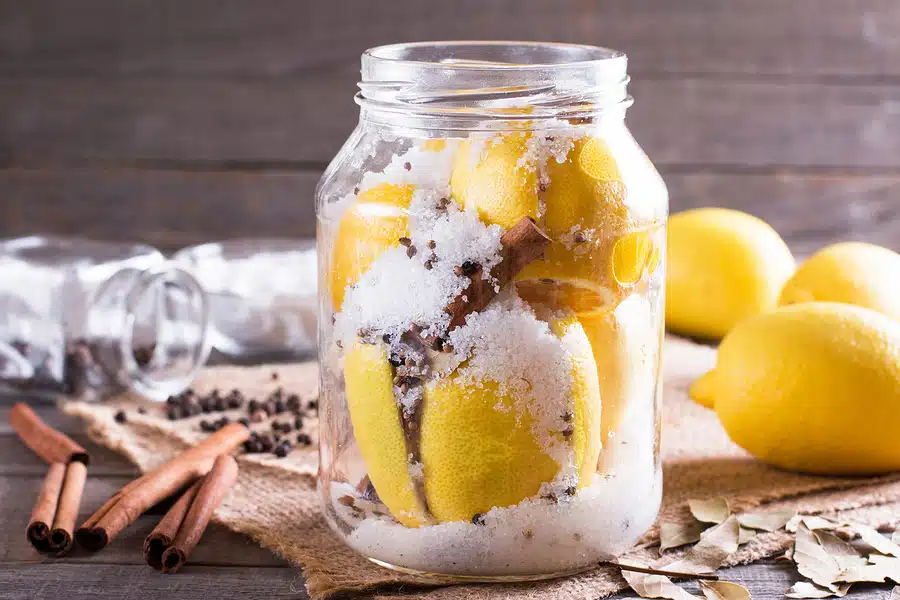I regularly use preserved lemon, adding it to salads, soups, dressings, and seasoning because of its exquisite umami flavor. The fermentation process transforms the lemon peel’s bitterness into a unique taste that will amaze you. Preserved lemon is also high in probiotics and contains liver detoxing essential oils in the peel. Use the rind and discard the pulp. It is a staple condiment in North Africa and is available at any Middle Eastern grocery.
It never stops to amaze me what fermentation can do to food. After all, let’s not forget that cheese, wine, dosa, and miso are all fermented foods as well. The preserved lemon is one of my personal favorites. I still remember being given a concoction made from Chinese “sour limes” when feeling under the weather. Sour limes are brown, shriveled and very sour, chopped, then added to hot water. These little gems were tangy, lemony, salty but not like their cousins, the fresh limes. The fermentation process, combined with the salt, changes the limes so much so that they taste like nothing you have ever tried.
My love for lemons and now fermented lemons, or preserved lemons as they are called in the Middle East, continues. Let me give you a few reasons why you could be enthusiastic as well:
- They are yet another potent fermented food that provides plenty of beneficial bacteria.
- The peel contains d-limonene which detoxifies the liver and helps get rid of “dirty” estrogens.
- The peel is alkalizing for the body.
- They last forever when kept in the fridge.
To use it in cooking, just rinse the salt off, remove the seeds and use the rind and/or pulp in your recipe. Chop up and add to salad dressings.
Recipes to try with preserved lemon:
Olive and Preserved Lemon Tapenade
Preserved Lemon Tonic
Preserved Lemon Dressing
Moroccan Chicken Tajin
In my cookbook, Cooking for Hormone Balance, there is also an easy and versatile recipe for the Olive and Preserved Lemon Tapenade and the Preserved Lemon Mayo.
Video: How to Make Preserved Lemons
- 6 organic lemons; 4 to ferment and 2 to get juice from
- 6 tablespoons of sea salt, or more
- 2 cinnamon sticks, optional
- 4 cloves, optional
- Sanitize the mason jar by washing it with soap and hot water. Do not use antibacterial soap.
- Wash the lemons with boiling water. Cut four of them lengthwise to quarter, but do not cut all the way so the lemon quarters remain connected at the base.
- Place 1 tablespoon sea salt at the bottom of the jar. Stuff one quartered lemon into the bottom of the jar, with the base of the lemon down. Pack it in tightly and press down to release the juice. Top with 1 tablespoon salt and the spices. Repeat with the other three quartered lemons. Add the remaining salt to the top.
- Juice the remaining two lemons and pour the juice into the jar. The lemons should be fully submerged. If they aren’t completely covered, place a small glass container in the mason jar to press the lemons down under the liquid, or add more lemon juice. Do not use a metal or plastic container.
- Tighten the lid of the jar and place it in a warm place away from direct sunlight.
- Turn the jar upside down every few days.
- Ferment for 30 to 60 days and check for readiness. The lemon rind should be very soft and no longer taste bitter.
- Transfer to the refrigerator. It will keep for years (I'm not exaggerating) but you will most likely finish them way before that!


in the ingredient list you mention 2 lemons for juice but in step 4 you say 4 lemons. Could you clarify?
Thanks
Hi Zita,
Please follow the recipe that is printed. “6 organic lemons; 4 to ferment and 2 to get juice from”. I hope that helps 🙂
~Deanna HB Team
How many lemons will go in the glass jar and how many will be juiced at the end?
Hi Ann Marie,
4 in the jar and 2 used for juice. I hope that helps. ~Deanna HB Team
Thank you so much for this amazing-sounding recipe. I already adore the preserved lemons I buy in – and use them in lots of dishes – but this fermented version sounds heaps better. Can’t wait to try it!
Great Jette!
More recipes are coming out! ~Deanna HB Team
The amount of salt called for in this recipe concerns me.
I do not have to watch my salt intake, but my hands and feet do get puffy if I eat too much of it.
Any comments?
Hi Mary,
It is part of the fermenting process and it is sea salt (as opposed to regular table salt). Sea salt has additional minerals and the body responds to it differently than regular table salt. This amount is just right for the preserving of the lemons. There is a difference that people see when they try it. ~Deanna HB Team
Was listening to video but did not quite get it. What do you do with the fermented mixture. zYou say freeze it and can rinse salt when you want to cook with it. What state is it in at this time. Also you show Himalayan salt in the video but recipe says sea salt
Could we use limes instead of lemons?
I made this earlier this year and have LOVED eating it in pretty much everything. Even great when I had a bad cold and was craving lemon for my throat.:) but now I’m wondering what to do with the leftover brine? I’m hoping I can still use it as well but want to check.
Yes, I was wondering the same thing too. If we are supposed to eat lemon rind only, do we discard all lemon juices and pulps?
I’m ready to start making this, yeah….
Thank you!
I also would like to know the answer to this question!
Hi Katie, I haven’t been able to locate any uses for the leftover brine and many recipes suggest gently rinsing the lemon brine off. If you find any recipes calling for the brine, please let us know:) ~ Jeanne HB Team
In the video you mentioned a way to keep the salt from a metal mason jar lid but said you would tells us later. You never came back to it in the video so I’m still wondering what you do. In the past I have used plastic to cover the jar then put the lid over it. I know plastic is not the healthiest option. I be interested in what you would do instead.
I would also love to know the answer to this question.
HI Britta – In answer to the above, Magdalena says…
1. I use parchment paper to separate the metal lid from the jar
2. I use the juice as well – in lieu of salt. I use the pulp as well but not the seeds.
Enjoy! Jen HB Support
HI Sharon – In answer to your question, Magdalena says…
1. I use parchment paper to separate the metal lid from the jar
2. I use the juice as well – in lieu of salt. I use the pulp as well but not the seeds.
Enjoy! Jen HB Support
Thank you for all your generous work, dziekuje even!!!
I lacto ferment anything and everytjing and have used the remaining brine ekther as a starter or to top up jArs with liquid when the fermenting godies need it.
Blessings
Marie-Helene
Can you explain washing the lime in boiling water? How long are they in boiling water?
How long are they in boiling water?
Just for a few seconds.
I made this and WOWZA is it good! The salt brings out the sweetness of the lemon but it still has that zing of lemon zest. Truly, this is a must try recipe! =)
Glad that you enjoyed it!
Has anyone tried this recipe with limes?
Hi Julia, we haven’t tried this recipe with limes. If you do, let us know how it turns out. ~HB Support
I fermented my lemons for 30 days and tried one. Is it supposed to be really salty? Maybe I did something wrong.
Hi Pam! Make sure to gently rinse the salt off of the lemon before tasting or using in a recipe, and remove the fruit from the rind as well. They should taste intensely lemony and have a umami kick, but should not taste overwhelmingly salty. 🙂
– HB Team
Two questions-
1) When you talk about washing the fruit before you make the recipe, you say to use hot water. Would there be a problem if you wash them in cool water with a bit of vinegar?
2) When the fruit is done fermenting you say to gently rinse the salt off and take off the fruit before eating it. Do you rinse it under water?
Hi Karyn! Thank you so much for reaching out and asking great questions.
1) You can absolutely use cool water with vinegar. The thought behind using hot water is to remove any “bad” bacteria, agricultural sprays, and any waxes that may have been added to the rind. Diluted vinegar will work just as well.
2) Yes, simply rinse the preserved lemons briefly under cool water to remove excess salt. You can then remove any seeds and either remove the pulp or keep it on the rind. Finally, chop into chunks or thinly slice and use as a condiment for salads, add to drinks, or other meals. We love them on Moroccan Chicken Tajin and in this Preserved Lemon Tonic.
We hope you enjoy them! ~HB Support.